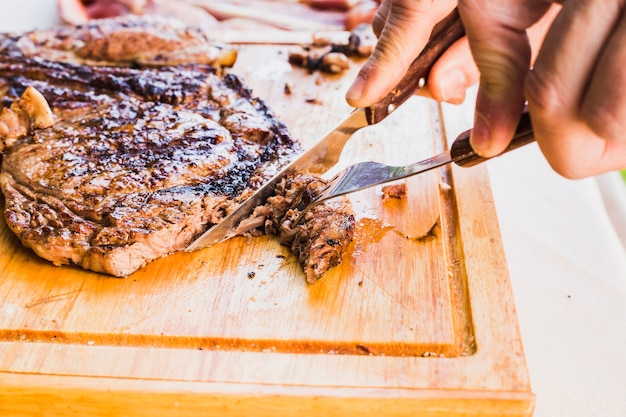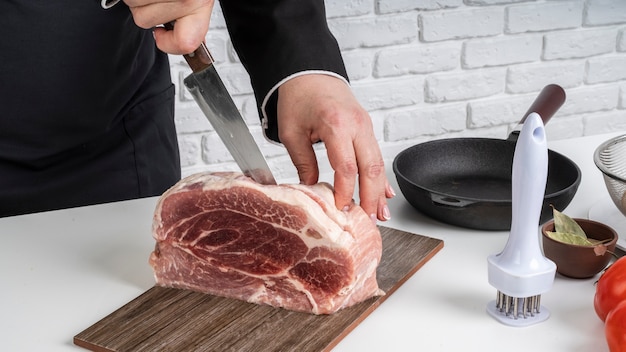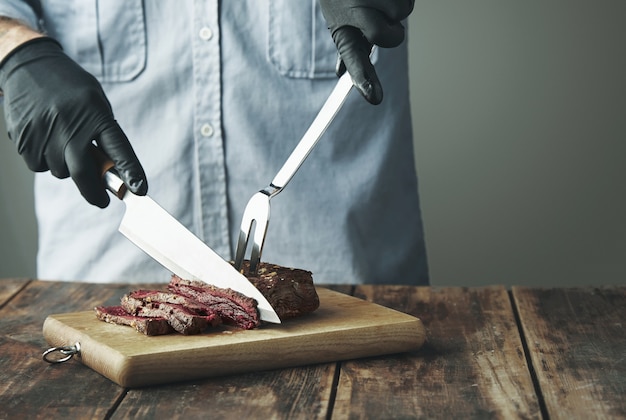Let's be honest, there's nothing quite like a perfectly cooked steak. You know, the kind that's got that beautiful crust on the outside, the irresistible aroma that fills the kitchen, and that juicy, tender interior that melts in your mouth. It's a culinary triumph, but getting it right can be a bit of a challenge. I've certainly had my fair share of steak disasters - those times when I've pulled a steak off the grill, thinking it's perfectly medium-rare, only to find it's closer to well-done. Talk about a culinary tragedy! But fear not, my fellow steak enthusiasts, because today, I'm sharing all the secrets I've learned about achieving the perfect steak temperature, no matter your preferred doneness. Buckle up, because we're about to take your steak game to a whole new level!
(Part 1) The Science of steak doneness - Unveiling the Mystery

Let's get down to the nitty-gritty, shall we? It all comes down to the internal temperature, my friends. The higher the temperature, the more cooked the steak becomes. Each level of doneness has a specific temperature range that determines its texture and flavour. Let's break it down, shall we?
Understanding the Different Levels of Doneness - A Journey Through Flavor
You've got your classic four levels of doneness, and then a few extra for those who really know their steak:
- Rare: This is the "just kissed by the grill" level. The centre will still be cool and slightly red, giving it a raw, primal essence. The texture is soft and tender, with a hint of chewiness. It's for those who appreciate the bold, almost wild flavour of beef.
- Medium-Rare: This is the gold standard, in my opinion. The centre is a beautiful pink, with a juicy and tender texture that offers a slight resistance when you bite into it. The flavour is well-balanced – not too gamey, not too bland. It's the perfect combination of tenderness and flavour.
- Medium: The steak is no longer pink in the centre, but it's still juicy and tender. The texture is a bit firmer than medium-rare, and the flavour is richer and more developed. This is where the meat begins to develop a deeper, more complex flavour.
- Medium-Well: The steak is cooked through, with only a hint of pink left in the centre. The texture is firm and slightly chewy, and the flavour is bold and robust. It's a good choice for those who prefer a more cooked steak, but still want some tenderness.
- Well-Done: This is the most cooked level, with the steak being entirely brown throughout. The texture is firm and chewy, and the flavour is the strongest and most developed. Personally, I find it a bit too tough and dry for my taste, but hey, to each their own! It's a classic for those who like their meat well-done.
Doneness Temperatures – A Quick Reference Table
Here's a handy table to keep in mind. It'll help you know exactly when your steak is reaching that perfect level of doneness:
| Doneness Level | Internal Temperature (°F) | Internal Temperature (°C) |
|---|---|---|
| Rare | 125-130 | 52-54 |
| Medium-Rare | 130-135 | 54-57 |
| Medium | 135-140 | 57-60 |
| Medium-Well | 140-150 | 60-65 |
| Well-Done | 150-160 | 65-71 |
Remember, these are just general guidelines. The ideal internal temperature for you may vary depending on your personal preferences and the thickness of the steak. For example, a thicker steak might need a bit more time to reach the desired doneness.
(Part 2) Getting Your Steak Ready: Preparation is Key!

Before you even think about firing up the grill or your oven, there's some prep work that needs to be done. Think of it as laying the foundation for a culinary masterpiece. These steps will make a world of difference in the final outcome of your steak, trust me!
1. choosing the right cut – Finding Your Perfect Match
Choosing the right cut of meat is a crucial first step. There are so many options out there – ribeye, sirloin, filet mignon, strip steak, and the list goes on. Each cut has its own unique flavour profile and texture. Do you want a steak that's rich and marbled like a ribeye? Or are you looking for a leaner option like sirloin? Take some time to think about what you're looking for in a steak, and then choose accordingly.
2. Letting it Rest – The Importance of Temperature
Don't cook your steak straight from the fridge, mate. It's essential to let it come to room temperature for about 30 minutes before you cook it. This allows the steak to cook more evenly and prevents the centre from becoming cold while the outside is already cooked. Think of it as a little bit of patience for a lot of flavour. It's like giving your steak a chance to warm up and relax before the cooking process begins.
3. Seasoning for Success – Adding Flavor with Every Grain
This is where you can really let your creativity shine. A simple salt and pepper rub is always a classic, but you can also experiment with different herbs, spices, and even a little bit of garlic powder. Don't be afraid to play around with different combinations and find your perfect flavour profile. Just remember, a little goes a long way. You want to enhance the natural flavour of the steak, not overpower it.
(Part 3) Cooking Your Steak to Perfection – Unlocking the Secrets

Now, we get to the fun part! There are many ways to cook a steak, and each method has its own advantages and disadvantages. Here are some of the most popular methods, each with its own unique charm and flavour profile:
1. The Grill – A Classic Choice
Grilling is a classic method for cooking steak. It adds those beautiful grill marks and a smoky flavour that is hard to beat. You can achieve a nice sear on the outside while keeping the inside perfectly tender. The key is to preheat your grill to medium-high heat and cook the steak for about 2-3 minutes per side. Don't forget to rotate the steak by 90 degrees halfway through to create those iconic crosshatch grill marks.
2. The Oven – A Controlled Environment
Cooking steak in the oven is a great option for when you want a more controlled environment. It's a bit more hands-off and allows you to cook multiple steaks at once. Preheat your oven to 400°F (200°C) and cook the steak for about 10-12 minutes for medium-rare. For a more even cook, you can place the steak on a wire rack over a baking sheet. This allows the heat to circulate around the steak and cook it evenly.
3. The cast iron pan – Versatility at its Finest
A cast iron pan is a truly versatile tool for cooking steak. It retains heat incredibly well, creating a beautiful sear on the outside and even cooking on the inside. Preheat your pan over high heat and cook the steak for about 2-3 minutes per side. Make sure the pan is properly seasoned to prevent sticking. You can also add a knob of butter to the pan towards the end of cooking to add a rich, buttery flavour to the steak.
4. The reverse sear – A Newcomer’s Triumph
This is a relatively new technique, but it's a game-changer for achieving perfectly cooked steak. The idea is to cook the steak low and slow first, ensuring even cooking throughout, and then finish it off with a high-heat sear for that delicious crust. It's a bit more time-consuming, but it's worth it. You'll end up with a steak that's tender and juicy all the way through, with a perfectly crisp exterior.
(Part 4) The Art of Resting: Let it Breathe!
Once you've cooked your steak to the perfect temperature, it's crucial to let it rest for at least 5-10 minutes before slicing and serving. This allows the juices to redistribute throughout the meat, making it even more tender and flavorful. Think of it as giving the steak a chance to recover from the heat and regain its moisture.
(Part 5) Temperature Monitoring: Your Steak's Best Friend
Here's the truth: cooking a steak without a thermometer is like driving without a map. It's a risky move, mate. A meat thermometer is your best friend when it comes to achieving the perfect level of doneness. It allows you to check the internal temperature of the steak accurately and ensure it's cooked to your liking. It's like a little extra insurance to ensure you don't end up with a steak that's undercooked or overcooked.
(Part 6) Making the Most of Leftovers: Don’t Waste a Bite!
Got leftover steak? Don’t fret! There are tons of ways to use leftover steak. You can slice it thin and add it to salads, sandwiches, or pasta dishes. You can also dice it up and toss it into stir-fries or create a hearty stew. Get creative, experiment, and don’t let those precious steak leftovers go to waste.
(Part 7) From Beginner to Pro – Mastering Your Steak Game
Let's face it, mastering the art of cooking steak takes practice. But with a bit of patience and these tips, you'll be on your way to becoming a steak grilling champion.
- Start Simple: Don't try to tackle too many techniques at once. Master the basics first – a good salt and pepper rub and a simple pan-sear.
- Experiment with Flavors: Once you've got the basics down, start experimenting with different seasonings and marinades. Try herbs, spices, citrus, garlic, or even a little bit of chili powder.
- Don't Be Afraid to Fail: Cooking is an art, not a science. There will be times when your steak doesn't turn out perfectly, and that’s okay. Learn from your mistakes and keep practicing.
- Join the Steak Community: There are so many resources available online and in cookbooks. Join a cooking forum, read blogs, and watch videos to get tips and inspiration from other steak enthusiasts.
(Part 8) FAQs: Your Steak Questions Answered
Here are some commonly asked questions about steak, along with detailed answers to help you achieve your steak goals.
1. How do I prevent steak from sticking to the pan?
To prevent your steak from sticking to the pan, make sure the pan is hot enough and use a little bit of oil or butter. You can also sear the steak for a shorter period of time on each side. If you’re using a cast iron pan, make sure it’s well-seasoned. A well-seasoned pan will have a smooth, non-stick surface that will help prevent your steak from sticking.
2. Can I use a meat thermometer on a frozen steak?
It's best to use a meat thermometer on a thawed steak, as a frozen steak will give inaccurate readings. Let your steak thaw completely before checking its internal temperature. This ensures that the thermometer is accurately measuring the temperature of the meat, not the frozen part.
3. What’s the best way to store leftover steak?
To ensure your leftover steak stays fresh, store it in an airtight container in the refrigerator for up to 3-4 days. You can also freeze leftover steak for up to 2-3 months. Just make sure to wrap it tightly in plastic wrap or aluminum foil before freezing. This will help prevent freezer burn and keep the steak fresh for longer.
4. What are some good sides to serve with steak?
Steak pairs perfectly with a variety of side dishes. Some classics include mashed potatoes, asparagus, roasted vegetables, and a green salad. You can also get creative with your sides and try something different, like risotto, polenta, or mac and cheese. The possibilities are endless!
5. Can I grill a steak that's been marinated?
Absolutely! Marinating your steak adds flavor and tenderness. Just make sure to pat it dry before grilling to prevent the marinade from burning. Marinades are a great way to add extra flavour to your steak. You can use a simple marinade of oil, vinegar, and herbs, or you can get more adventurous with your marinade and use ingredients like soy sauce, honey, or chili flakes.
Alright, my fellow steak lovers, there you have it! A comprehensive guide to achieve the perfect steak temperature, no matter your preferred doneness. Now go forth and grill, sear, and bake those juicy, flavorful steaks with confidence. Happy cooking!
Everyone is watching

Prime Rib Roast Cooking Time Chart: Per Pound Guide
Cooking TipsPrime rib roast. Just the name conjures images of lavish dinners, crackling fires, and hearty laughter. It’s ...

How Long to Bake Potatoes in the Oven (Perfect Every Time)
Cooking TipsBaked potatoes are a staple in my kitchen. They're incredibly versatile, delicious, and surprisingly easy to m...

Perfect Rice Every Time: The Ultimate Guide to Cooking Rice
Cooking TipsAs a self-proclaimed foodie, I've always been a bit obsessed with rice. It's the foundation of countless cuisi...

The Ultimate Guide to Cooking Asparagus: Tips, Techniques, and Recipes
Cooking TipsAsparagus. The mere mention of this spring delicacy conjures up images of vibrant green spears, crisp and burs...

Ultimate Guide to Cooking the Perfect Thanksgiving Turkey
Cooking TipsThanksgiving. Just the word conjures up images of overflowing tables laden with delicious food, the scent of r...
